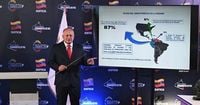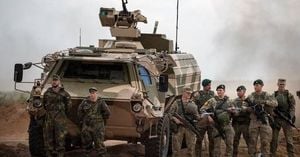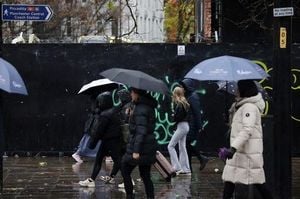Tensions are running high in the Caribbean as Venezuela and the United States engage in a dramatic military standoff, with both nations deploying warships, troops, and surveillance technology in a contest that has drawn global attention and raised concerns about regional stability. The latest developments unfolded on Tuesday, August 26, 2025, when Venezuela’s Defense Minister Vladimir Padrino announced a significant deployment of military vessels and drones to patrol the nation’s coastline, responding directly to the United States’ recent military build-up just off Venezuelan waters.
According to Oilprice.com and corroborated by Al Jazeera, Padrino revealed on social media that Venezuela would be sending larger naval ships north of Lake Maracaibo, a region notable for its bustling oil ports—including those used by Chevron to export Venezuelan heavy crude to the U.S. Gulf Coast. The defense minister emphasized the scale of the operation, stating that drones would also be deployed for surveillance, with “larger vessels further north in our territorial waters.”
This military maneuver comes hot on the heels of a U.S. decision, ordered by President Donald Trump earlier in August, to send three warships—later joined by a guided missile cruiser and a nuclear-powered fast-attack submarine—toward Venezuela’s coast. The stated aim, according to the White House and reported by CBS and AFP, is to confront Latin American drug cartels, which the Trump administration accuses of working in concert with Venezuela’s government.
The U.S. naval build-up is no small affair. News agencies report that some 4,500 American service members, including 2,200 Marines, have been deployed as part of this operation. The move follows a pattern of escalating rhetoric and action from Washington, which has also doubled the reward for the capture or prosecution of Venezuelan President Nicolás Maduro on drug charges from $25 million to $50 million as of August 7, 2025. The U.S. has similarly offered $25 million for Interior Minister Diosdado Cabello, both accused of leading the so-called Cartel de los Soles, a cocaine trafficking organization designated as a terrorist group by the U.S. government.
Maduro has not taken these accusations or the military pressure lightly. In a televised address on Monday, August 25, 2025, he insisted, “Venezuela is a clean territory, free of drug trafficking… free from coca leaf crops, free! Free from cocaine production.” He further criticized what he described as U.S. hypocrisy, pointing to America’s own struggles with drug consumption while rejecting the narrative that Venezuela is a major producer or trafficker of illicit substances.
In response to what Caracas views as “outlandish threats” from the U.S., Maduro has mobilized hundreds of thousands of local militia members, with thousands signing up in Caracas over the weekend. These efforts are meant to strengthen national security and demonstrate popular support for the government amid external pressure. Additionally, Venezuela has deployed 15,000 troops and surveillance drones to its border with Colombia, a region long plagued by criminal groups and drug trafficking. Interior Minister Diosdado Cabello announced that the troop deployment aimed to bolster security in Zulia and Táchira states, both bordering Colombia, and reported the seizure of 53 tons of drugs so far in 2025.
Meanwhile, Defense Minister Padrino disclosed that Venezuelan security forces had dismantled shipyards in the country’s northeastern corner, where criminals had planned to manufacture semisubmersibles and boats for transporting drugs by sea to Europe and North America. These “semisubmersibles”—vessels that can partially submerge and thus evade law enforcement—are a favored tool among international traffickers, and their discovery underscores the ongoing battle against organized crime on both sides of the border.
Venezuela’s mission to the United Nations did not remain silent amid the mounting military presence in the Caribbean. In a letter reported by Noticias Venevision, the Venezuelan government denounced the U.S. military actions as “a serious threat to regional peace and security,” specifically highlighting the arrival of a nuclear-powered submarine as “a clear act of intimidation.” The letter demanded that Washington provide “guarantees” against the deployment or threat of nuclear weapons in the region, emphasizing the gravity of the situation and the potential for escalation.
Despite the saber-rattling, analysts have generally downplayed the prospect of a direct U.S. invasion or military strike on Venezuela. As AFP noted, many Venezuelans themselves seem to shrug off the threat, viewing the military build-up as more posturing than prelude to war. Phil Gunson of the International Crisis Group told AFP, “I think what we’re seeing represents an attempt to create anxiety in government circles and force Maduro to negotiate something.” This sentiment is echoed in the streets of Caracas, where the public appears more concerned with day-to-day survival than the specter of foreign intervention.
The broader context of this standoff is rooted in years of fraught U.S.-Venezuela relations. Maduro, who claimed a third term in office following a July 2024 election widely described as deeply flawed and marred by a crackdown on opposition, has been a persistent target of U.S. “maximum pressure”—a policy that has included a sweeping oil embargo, sanctions, and diplomatic isolation. Yet, as multiple sources note, these measures have so far failed to dislodge Maduro from power or force meaningful concessions from his government.
The economic dimension cannot be ignored. The Gulf of Venezuela, now bristling with naval activity, is home to vital oil ports. Chevron, which had been producing around 240,000 barrels per day in partnership with Venezuelan state firms before U.S. sanctions, recently resumed some operations after a period of forced withdrawal. This output is significant, nearly matching Venezuela’s total average daily exports to the United States for the year, according to data from Kpler. Still, the country’s overall oil exports remain depressed at roughly 700,000 barrels daily, a far cry from its heyday before sanctions and political turmoil.
The U.S. military’s stated justification—combating drug cartels—has been met with skepticism in Caracas, where officials see it as a pretext for regime change. Maduro has repeatedly accused the Trump administration of seeking to topple his government, a charge that resonates with his supporters and fuels anti-American sentiment. Meanwhile, Washington maintains that its actions are aimed at curbing the flow of fentanyl and other illicit drugs into U.S. communities, pointing to the violence and addiction crises plaguing American cities.
As the world watches the unfolding drama in the Caribbean, the stakes remain high for both nations and the wider region. The risk of miscalculation is real, even if outright conflict appears unlikely for now. Both sides seem intent on flexing their muscles and sending clear messages, but the underlying issues—drug trafficking, political legitimacy, and the struggle for influence—are far from resolved. For ordinary Venezuelans, the military maneuvers may be just another chapter in a long saga of hardship and uncertainty, but for regional observers, they are a reminder of how quickly geopolitical tensions can escalate in an already volatile neighborhood.
For now, the ships patrol, the drones buzz overhead, and the world holds its breath, waiting to see whether diplomacy or brinkmanship will win the day in the Caribbean.





